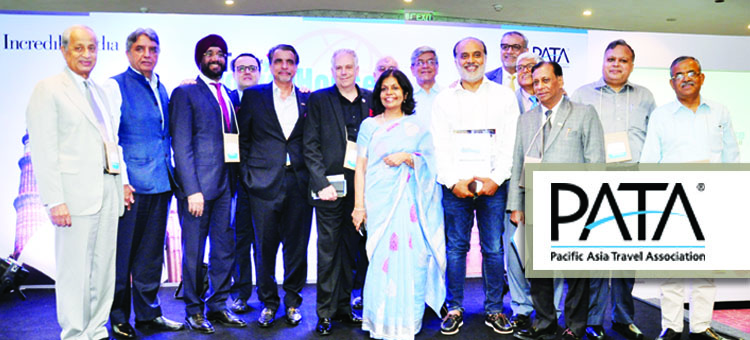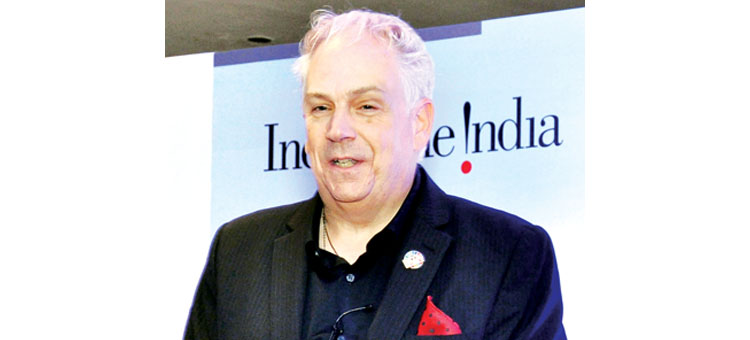New Delhi: Pacific Asia Travel Association (PATA) India Chapter organised its maiden Tourism PowerHouse 2018 at The Park, New Delhi on August 5 and 6, 2018. The initiative was aimed at igniting the minds of tourism industry leaders and fully tapping the immense potential of India in line with the global best practices.
Over 200 delegates took part in the event which aimed to ignite the minds of tourism industry leaders and fully tap the immense potential of India in line with the global best practices
Rashmi Verma IAS, Secretary Tourism, Government of India (GoI) and Chairperson, PATA India Chapter, led the event along with Dr. Mario Hardy, CEO, PATA.
The keynote address on ‘Tourism Trends and Opportunities’ was delivered by John Koldowski, an international tourism research expert. Nearly 200 delegates took part in the event. An eclectic mix of speakers addressed the audience on the opportunities and challenges.
Delegates got the opportunity to network, learn, and interact with knowledge leaders and industry stalwarts and also participate in engaging discussions on digital marketing, tourism disrupters and enablers, luxury travel trends and more.
Strategies to grow FTAs
Rashmi Verma IAS said the purpose of this initiative is to introspect and look at challenges and opportunities in the tourism sector. “We want to draw a roadmap of where we want to be in the next few years. In 2017, we grew 15 per cent on FTAs when the world tourism industry registered only 7-8 per cent. On the domestic tourism front also India witnessed commendable growth. There are a lot of positives as far as tourism in India is concerned.”
India ranked 13th in terms of earnings and 25th in terms of arrivals worldwide in 2017. Tourists are spending more time and money in India. Increasingly tourism is being recognised as a key player contributing to the economy through foreign exchange earnings and employment generation.
That is precisely why the GoI is focusing on tourism in a big way. The Ministry of Tourism (MoT), thanks to its good performance last year, has been awarded a bigger budget in FY 2018-19, which means it can spend more on promotional activities as well as creation of infrastructure. MoT is adopting a three-pronged strategy for enhancing FTAs:
G2G Interaction: About 63 MoUs have been signed so far with other countries for promoting two-way tourism between geographies. The e-Visa program has been extended to 166 countries so far and has been a game changer.
B2B Engagement: MoT is participating in all major world tourism marts like ITB, WTM, ATM, BITE and FITUR as well as engaging with trade bodies like FAITH, PATA, IATO, TAAI and ATOAI.
Roadshows are also being organised overseas along with industry stakeholders in focus markets. “For the first time, we are organising India Travel Mart (ITM) from September 16-18, with 250 buyers participating from across the globe. We are giving a platform to not only big players but smaller and medium-sized businesses who may not be able to travel abroad for the travel shows,” added Secretary Verma.
Another flagship event, The International Buddhist Conclave with focus on B2B meetings, concluded in late August with 150 opinion makers, tour operators and monks from 24 Buddhist countries participating.
B2C Outreach: “This is equally important,” said the Secretary. “But we have many challenges. We have to know whom to target and where to target; which countries and what age groups; what income groups and with what interests?
In 2002, MoT first created a campaign for India Tourism to help build awareness on destinations. But currently, the focus is to undertake campaigns that are interest focused. This has been commissioned after conducting deep research in potential markets.
The Incredible India 2.0 campaign targets travellers in key and emerging markets, focusing on niche products and experiences. This has been corroborated by research and market studies. For example, luxury is what US travellers are looking for while the Germans go for Ayurveda and Yoga. Hence the new campaigns and marketing assets have been created based on these insights.
MoT has rolled out a global media plan with mainstream media, travel media and digital channels. The media mix this time is 60 per cent on digital, 30 per cent on electronic media and remaining on print.
“The film ‘Yogi of the Racetrack’, which promotes Ayurveda, clocked 20 million views in the first month when it was launched at ITB 2018. This year we are focusing on adventure tourism and have declared 2018 as Adventure Tourism Year. Next year, the PATA Adventure Travel and Responsible Tourism Conference & Mart will be held in Rishikesh. We are now making a film on adventure tourism.”
The MoT is using thematic films in foreign languages on wildlife and luxury to promote India in source markets depending on their interests. “Earlier we used to target older people for Ayurveda and Yoga. But now we are targeting the youth. The whole focus has shifted. The youth is looking at unique experiences which can be created by involving local communities,” she said.
The Incredible India website was recently revamped, making it more interactive and personalised. The site has been receiving tremendous response since its re-launch.
One of the biggest challenges India has had for years is that tourism has been seasonal. This creates anxiety for the industry. Adventure, medical and cruise tourism can help make India a year-round destination. “We have a policy in place for adventure tourism now. We are creating an institutional mechanism for promoting medical tourism. India is one of the top five MVT destinations already.”
GoI has committed heavy investments into building cruise terminals because it sees tremendous potential as many Indians are travelling on cruises. Today, Indian cruise passengers embark from Singapore as many cruise liners are home ported there due to lack of world-class infrastructure in India. The e-Visa program has already been extended to cruise tourists. The Union Home Ministry has also done away with biometrics for cruise tourists on e-Visa.
Many destinations in India lack basic tourist-friendly infrastructure and amenities. Infrastructure development has been a key focus of the government to enhance tourist experience around the major sites. 12 destinations have been selected as ‘Iconic Tourist Sites’ for holistic development.
MoT’s flagship schemes, Swadesh Darshan and PRASHAD, are extending generous support to the states to create infrastructure as well as operate them. ‘Adopt a Heritage’ is another innovative scheme of MoT to join hands with private or public sector undertakings to manage key tourism facilities. Red Fort will be the first facility to be managed by a private sector entity.
While detailing India’s plans to up the game as far as FTAs are concerned, Secretary Verma cautioned the audience about the ills of overtourism. “We have to look at where we want to go. Sought after destinations like Barcelona and Vienna are turning away tourists today. We are getting 10 million tourists and can easily take in 30 million. But when we build a strategy for growth we have to do it responsibly, learning from experiences of others.”
The best way to avoid the perils of overtourism is to open up new destinations, improve connectivity, build attractions and help decongest popular destinations. Today, destinations like Shimla, Manali, Nainital and Dalhousie are overcrowded.
The UDAN regional air connectivity scheme is helping improve air connectivity substantially. 50 airports are going to be operationalised very soon. Twenty seven new routes have been selected and some flights have started operations, including to the North East.
Another 80 routes have been selected under phase II of UDAN. MoT has recommended 22 ‘very important’ routes to the Ministry of Civil Aviation. These include unserviced and underserviced routes to promote tourism. “Each State has unique experiences to offer, but are currently promoting everything and creating massive infrastructure. It is time for states to introspect and understand their USP and focus only on that, and not try to be everything to everyone. This way India can welcome tourists to all parts of the country,” she said.
‘Don’t underestimate the power of storytelling’
At PATA India Tourism Powerhouse 2018, CEO Dr. Mario Hardy spoke about the power of storytelling. “If you want to entice people to visit your destinations, if you want them to make the journey, then they have to hear your mysteries and stories. If you want 30 million visitors to come to India, you need to tell beautiful stories of your villages, people, landscape, history, culture, food and religions.”
According to him, we can tell our stories by speaking, writing, creating videos and sharing them in a lot of ways including social media. “Storytelling is the responsibility of India’s 1.2 billion people. The greatest thing about tourism is it educates us about us. You will get to know me; I will get to know you.”
In the last 12 to 18 months PATA has been increasing the number of engagement activities and one of those is human capital development. “One of the greatest success stories of our trainings is the art of storytelling.”
Dr. Hardy cautioned the industry about the perils of overtourism. 1.3 billion people have crossed borders last year and this number is certain to grow this year as more and more people are travelling. “While it increases wealth for all of us in this industry, it poses challenges, too, like infrastructure, waste management, water, power, and many more. Are we prepared for this growth for the next decade when we reach 2 billion tourists travelling?”
Dr. Hardy argued about the other side of this issue. “If there weren’t any people visiting these cities who would have built the economy? What about the jobs? Tourism is key to the economy of many nations around the world and it is very measurable. We need a balanced approach in this developing conversation which today is quite one-sided.”
He also posed some serious questions to the gathering.
“Technology is gravely impacting our sector for the better. It is enhancing customer experience and also our ability to understand and cater to very specific customer needs and expectations. When AI and automation comes in, it will result in some traditional jobs going away. Can tourism make up for those lost jobs? The cost of solar energy has drastically reduced, which is good news for our industry as we can continue to grow and still be green.”
Studies state that by 2050 there will be 11 billion people living on this earth and by 2030, 80 per cent of the population will be living in cities. “Think about the implications around infrastructure; amenities, food. How will it impact tourism when outsiders also visit your cities? Should we reconsider our lifestyles? Do we want a city life forever?”






